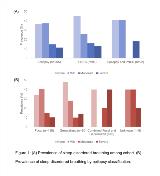Sleep-Disordered Breathing Among Patients Admitted for Video-EEG Monitoring
Abstract number :
2.010
Submission category :
3. Neurophysiology / 3A. Video EEG Epilepsy-Monitoring
Year :
2018
Submission ID :
501308
Source :
www.aesnet.org
Presentation date :
12/2/2018 4:04:48 PM
Published date :
Nov 5, 2018, 18:00 PM
Authors :
Shobi Sivathamboo, University of Melbourne, The Royal Melbourne Hospital; Sarah Farrand, The Royal Melbourne Hospital; Zhibin Chen, University of Melbourne; Elise White, The Royal Melbourne Hospital; Andreas Pattichis, University of Melbourne, The Royal M
Rationale: To identify the prevalence and risk factors of sleep-disordered breathing in individuals with epilepsy and psychogenic non-epileptic events (PNES). Methods: We conducted a cross-sectional study of consecutive patients admitted for prolonged video-EEG monitoring at The Royal Melbourne Hospital, Australia between December 1, 2011 and July 31, 2017. Participants underwent investigations during their monitoring period that were conducted as part of routine clinical care, including polysomnography, neurocognitive testing, and validated screening instruments of daytime somnolence, perceived sleep quality, and quality of life. Comparisons between groups were performed using Fisher’s exact test. Simple logistic regression and multivariable logistic regression model with penalized likelihood estimator were used to examine the association between sleep-disordered breathing and various demographic and clinical variables. Results: Our study population consisted of 370 participants who received a diagnosis of epilepsy (n=255), PNES (n=93), or both disorders (n=22). Of the 370 participants, 226 (61.1%) met criteria for sleep-disordered breathing (defined by an apnea-hypopnea index =5). Figure 1a shows the prevalence and severity of sleep-disordered breathing in our cohort. Moderate-to-severe sleep-disordered breathing (defined by an apnea-hypopnea index =15) was observed in 26.5% (98/370) individuals. There was no difference in the prevalence of moderate-to-severe sleep-disordered across patients with epilepsy 26.3% (67/255), PNES 29.0% (27/93), or both disorders 18.2% (4/22; p=0.610).Figure 1b shows the prevalence of sleep-disordered breathing by epilepsy classification. Subjects with combined focal and generalized epilepsy 60.0% (3/5) and unknown-type epilepsy 60.0% (3/5) had the highest prevalence of moderate-to-severe sleep-disordered breathing, followed by focal epilepsy 25.1% (49/195), and generalized epilepsy 24.0% (12/50), although no significant differences were found across groups (p=0.092). In multivariable analysis, independent predictors for moderate-to-severe sleep-disordered breathing in epilepsy were higher body-mass index (OR 1.06, 95% CI: 1.01-1.11; p=0.029) and older age (OR 1.07, 95% CI: 1.04-1.10; pp=0.002). Conclusions: Routine polysomnography during prolonged video-EEG monitoring identifies a substantial number of patients with undiagnosed sleep-disordered breathing. Sleep-disordered breathing was more common in patients with PNES, who were more likely to be female and obese. Identification of risk factors may improve management of sleep-disordered breathing in these populations. Funding: S.S. is supported by a Ball Grant from the Royal Melbourne Hospital Neuroscience Foundation. P.P. is supported by a Bridging Postdoctoral Fellowship from Monash University. P.K. is supported by a Practitioner Fellowship from the National Health and Medical Research Council of Australia. T.O. receives is supported by a Program Grant from the National Health and Medical Research Council.
